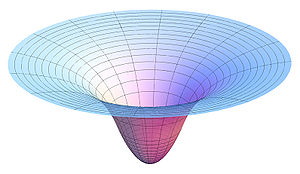Force field (physics): Difference between revisions
it should be merged with another article |
Sbyrnes321 (talk | contribs) substantial rewrite |
||
| Line 3: | Line 3: | ||
[[Image:GravityPotential.jpg|thumb|300px|Plot of a two-dimensional slice of the gravitational potential in and around a uniform spherical body. The [[inflection point]]s of the cross-section are at the surface of the body.]] |
[[Image:GravityPotential.jpg|thumb|300px|Plot of a two-dimensional slice of the gravitational potential in and around a uniform spherical body. The [[inflection point]]s of the cross-section are at the surface of the body.]] |
||
In [[physics]] a ''' |
In [[physics]] a '''force field''' is a special kind of [[vector field]] that describes the intensity of a [[non-contact force]] at various positions in [[space-time]]. |
||
Specifically, a force field is a vector field <math>\vec{F}(\vec{x})</math>, where <math>\vec{F}</math> is the force that a particle would feel if it were at the point <math>\vec{x}</math>.<ref>[http://books.google.com/books?id=akbi_iLSMa4C&pg=PA211 Mathematical methods in chemical engineering, by V. G. Jenson and G. V. Jeffreys, p211]</ref> |
|||
==Advantages and Restrictions== |
|||
An important point to remember when employing force fields is that the [[vector field]] in question does not exist. It is a map of the vectors which ''would'' exist, were a particle in that location in that moment; this kind of mathematical tool is called a [[Kuhnian construct]]{{Citation needed|date=August 2010}}. The force field is linked inseparably from the [[Line of force|lines of force]] one object exerts on another object or a collection of other objects. The force field is simply a collection of many of these lines in one location. |
|||
==Examples of force fields== |
==Examples of force fields== |
||
*In [[Newtonian gravity]], a particle of mass ''M'' creates a [[gravitational field]] <math>\vec{g}=\frac{-G M}{r^2}\hat{r}</math>, where the radial unit vector <math>\hat{r}</math> points away from the particle. The gravitational force experienced by a particle of mass ''m'' is given by <math>\vec{F} = m \vec{g}</math>. This field <math>\vec{F}</math> is the force field for gravity.<ref>[http://books.google.com/books?id=LiRLJf2m_dwC&pg=PA288 Vector calculus, by Marsden and Tromba, p288]</ref><ref>[http://books.google.com/books?id=bCP68dm49OkC&pg=PA104 Engineering mechanics, by Kumar, p104]</ref> |
|||
*A local [[Newtonian gravitational field]] near Earth ground typically consists of a uniform array of vectors pointing in one direction---downwards, towards the ground; its force field is represented by the [[Vector (geometric)|vector]] <math>\vec{F}=m\cdot g (-\hat{z})</math>, where <math>\hat{z}</math> points in a [[Direction (geometry, geography)|direction]] away from the ground, and m refers to the mass, and g refers to the [[acceleration]] due to [[gravity]]. |
|||
*An [[electric field]] <math>\vec{E}</math> is a vector field. It exerts a force on a [[point charge]] ''q'' given by <math>\vec{F} = q\vec{E}</math>. |
|||
*A global [[gravitational field]] consists of a spherical array of vectors pointing towards the center of gravity. Its classical force field, is represented by the vector, <math>\vec{F}=\frac{G m M}{r^2}(-\hat{r})</math>, which is just [[Newton's Law of Gravity]], with the radial unit vector <math>\hat{r}</math> pointing towards the origin of the sphere (center of the Earth). |
|||
*A conservative [[electric field]] has an [[electric charge]] (or a distribution of electric charges) as its source object. In the case of point charges, the force field is represented by <math>\vec{F}=\frac{kqQ}{r^2}(-\hat{R})</math>, where <math>\vec{R}</math> is the vector displacement of the charges. |
|||
==Restriction to position-dependent forces== |
|||
* A static [[magnetic field]] has a magnetic charge (a [[magnetic monopole]] or a charge distribution). |
|||
Some forces, including [[friction]], [[air drag]], and the [[Lorentz force|magnetic force]] on a charged particle, depend on the particle's velocity as well as its position. Therefore these forces are not characterized by a force field. |
|||
==Work done by a force field== |
|||
As a particle moves through a force field along a path ''C'', the work done by the force is a [[line integral]] |
|||
:<math> W = \int_C \vec{F} \cdot d\vec{r}</math> |
|||
This value is independent of the velocity that the particle travels along the path. For a [[conservative force|conservative force field]], it is also independent of the path itself, but depends only on the starting and ending points. If the starting and ending points are the same, the work is zero for a conservative force field. |
|||
==See also== |
==See also== |
||
Revision as of 21:04, 31 January 2011
It has been suggested that this article be merged with Field (physics). (Discuss) Proposed since April 2010. |

In physics a force field is a special kind of vector field that describes the intensity of a non-contact force at various positions in space-time.
Specifically, a force field is a vector field , where is the force that a particle would feel if it were at the point .[1]
Examples of force fields
- In Newtonian gravity, a particle of mass M creates a gravitational field , where the radial unit vector points away from the particle. The gravitational force experienced by a particle of mass m is given by . This field is the force field for gravity.[2][3]
- An electric field is a vector field. It exerts a force on a point charge q given by .
Restriction to position-dependent forces
Some forces, including friction, air drag, and the magnetic force on a charged particle, depend on the particle's velocity as well as its position. Therefore these forces are not characterized by a force field.
Work done by a force field
As a particle moves through a force field along a path C, the work done by the force is a line integral
This value is independent of the velocity that the particle travels along the path. For a conservative force field, it is also independent of the path itself, but depends only on the starting and ending points. If the starting and ending points are the same, the work is zero for a conservative force field.
See also
References









